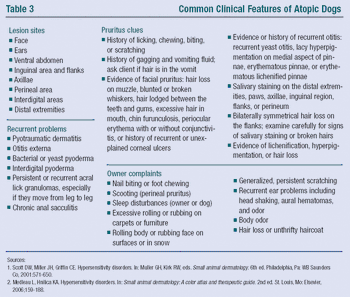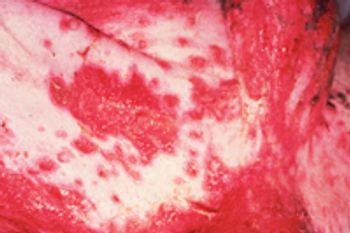
Karen A. Moriello, DVM, DACVD
Department of Medical Sciences
School of Veterinary Medicine
University of Wisconsin
Madison, WI 53706
Articles by Karen A. Moriello, DVM, DACVD




Benefit from these dermatology lessons for scoping out conditions in dogs and cats, many of which were learned after difficult or awkward moments.

The goal of this seminar is to highlight common and uncommon causes of feline facial disorders via clinical presentation or client complaint. Two diseases, idiopathic facial dermatitis of Persians and pemphigus, will be discussed in more detail.

Cats have compound hair follicles. In general, there is a cluster of two to five primary hairs surrounded by groups of smaller secondary hairs. One primary hair is the largest (central) surrounded by groups of small primary hairs (lateral primary hairs).

In practices, bio-hazard considerations consist of common sense and wearing laboratory coats and gloves and following basic good laboratory practices.

The importance of a thorough history is common knowledge. It is difficult to argue the usefulness of pre-printed history questionnaires when the diagnosis is obvious (e.g. fleas in your face) at the time of first presentation.

The veterinary clinic and exposure to fungal spores

As cats age, they are predisposed to skin diseases and changes in the hair coat as a result of age and development of other medical problems. This seminar will discuss the most common and noteworthy skin diseases of older cats.

A recent multi-center study investigating the causes of hypersensitivity dermatitis (HD) in cats has revealed some interesting findings that are clinically useful.

In the simplest terms, allergic dermatitis refers to any inflammatory skin disease caused by any type of allergy. The unifying characteristic of these diseases is that they cause pruritus and subsequent inflammation. Depending on the etiology, the event may be short-lived or become a lifelong condition. Table 1 lists the reported allergic diseases of small animals. 1,2 These diseases are rarely uncomplicated and often involve secondary infections. Furthermore, more than one core allergic disease is often present concurrently. These factors can make diagnosis and management of allergic dermatitis cases challenging.

A 2-year-old intact male Siamese cat was presented to the University of Wisconsin School of Veterinary Medicine's Dermatology Service for evaluation of self-mutilation and psychogenic licking of the forelimbs and abdomen.

In a recent study, oral dextromethorphan hydrobromide was evaluated in 14 dogs with atopic dermatitis to determine whether the drug had any effect on repetitive behaviors associated with or suggestive of pruritus.

Ulcerative dermatosis of Shetland sheepdogs and rough collies is an inflammatory, erosive skin disorder of unknown etiology.

A 1-year-old 66-lb (30-kg) intact male Labrador retriever was presented to the University of Wisconsin School of Veterinary Medicine's Dermatology Service for evaluation of severe pruritus and skin eruptions on its trunk and distal extremities.

The internal medicine service at the Veterinary Medical Teaching Hospital at the University of Wisconsin School of Veterinary Medicine requested a consultation on a 7-year-old intact male Boston terrier in which pituitary-dependent hyperadrenocorticism had been diagnosed one month earlier.

Cyclosporine is an immunosuppressive drug that suppresses T-helper and T-suppressor cells and inhibits interleukin-2.
Latest Updated Articles
 Dermatology Challege: Severe facial pruritus in a Boston terrier
Dermatology Challege: Severe facial pruritus in a Boston terrierPublished: August 1st 2004 | Updated:
 Dermatology Update: Using the new cyclosporine formulation in dogs
Dermatology Update: Using the new cyclosporine formulation in dogsPublished: April 1st 2004 | Updated:
 Canine allergic dermatitis: Pathogenesis, clinical signs, and diagnosis
Canine allergic dermatitis: Pathogenesis, clinical signs, and diagnosisPublished: June 1st 2006 | Updated:
 Dermatology Update: Can dextromethorphan be used to treat repetitive itching and scratching in atopic dogs?
Dermatology Update: Can dextromethorphan be used to treat repetitive itching and scratching in atopic dogs?Published: January 1st 2005 | Updated:
 Dermatology Update: A new look at ulcerative dermatosis of Shetland sheepdogs and rough collies
Dermatology Update: A new look at ulcerative dermatosis of Shetland sheepdogs and rough colliesPublished: December 1st 2004 | Updated:
 Dermatology Challenge: Self-mutilation and over-grooming in a Siamese cat
Dermatology Challenge: Self-mutilation and over-grooming in a Siamese catPublished: February 1st 2005 | Updated: